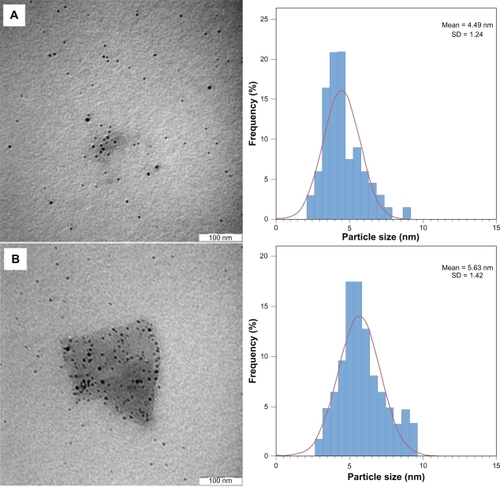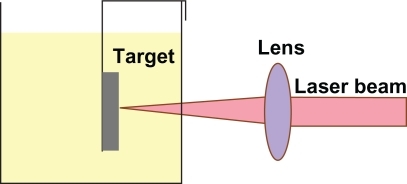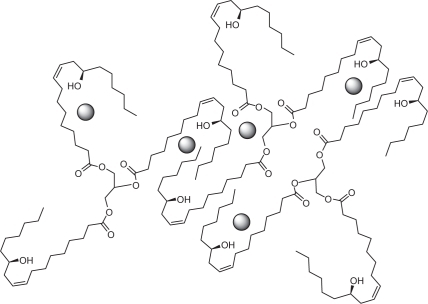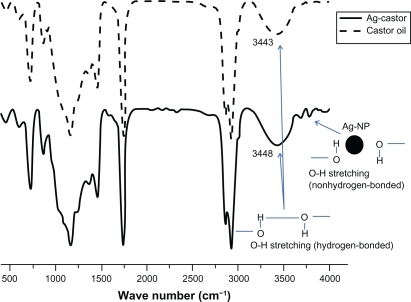Abstract
Silver nanoparticles were fabricated by ablation of a pure silver plate immersed in castor oil. A Nd:YAG-pulsed Q-switch laser with 1064-nm wavelength and 10-Hz frequency was used to ablate the plate for 10 minutes. The sample was characterized by ultraviolet-visible, atomic absorption, Fourier transform-infrared spectroscopies, and transmission electron microscopy. The results of the fabricated sample showed that the nanoparticles in castor oil were about 5-nm in diameter, well dispersed, and showed stability for a long period of time.
Introduction
Currently, nanoparticles (NPs) are used in several scientific applications, but among these silver nanoparticles (Ag-NPs) are predominant. This is because of several characteristic features of this type of metal NP.Citation1–Citation3 Antimicrobials and nanocomposite fabrication are some of the highly useful applications, among others, of applications that were attributed to Ag-NP.Citation4,Citation5 In the fabrication of NPs, it is very important to control particle size, shape, and morphology. Laser ablation in liquid media is a simple and clean method for synthesis of NPs.Citation6–Citation9 In this technique, there is no need to use any chemical reagents (such as NaBH4) in the fabrication process or any purification techniques to characterize the produced NPs.
Agglomeration of particles is a big challenge in the synthesis of NPs. Much research work has been done to overcome this challenge. For example, NPs using fatty acids (oleic and lauric acid) and vegetable oils as stabilizers have been synthesized.Citation10–Citation12 It was found that these materials consist of amphiphilic molecules with polar carboxylic groups which are able to adsorb NPs, and their nonpolar long carbon chain prevents NPs agglomeration through steric repulsion.
Castor oil is a vegetable oil obtained by cold pressing the seeds and subsequent clarification of the oil by heat. It has high viscosity, high polarity, and very low vapor pressure and optical activity in comparison with other oils. Castor oil is classified as a safe and effective stimulant laxative by the US Food and Drug Administration (FDA). It is a triglyceride containing fatty acid chains, 90% of which are ricinoleic acid. Oleic and linoleic acids are the other significant components.Citation12 With the above characteristics, it is expected that castor oil can be used as a good stabilizer in NPs fabrication. In this study, we report fabrication of Ag-NPs in castor oil. To the best of our knowledge, fabrication of Ag-NPs in castor oil using laser ablation has not been reported previously.
Experimental
For the fabrication of Ag-NPs, a silver plate was ablated by laser in castor oil for 10 min. As shown schematically in , the plate with high purity (>99.99%) was located 5 mm behind a glass cell wall filled with 10 mL of castor oil. A nanosecond-pulsed Q-Switched Nd:YAG laser (Brilliant; Lambda Photometrics Ltd, Hertfordshire, UK) with 10-Hz repetition rate, 5-ns pulse duration, and 360 mJ/pulse energy at its original wavelength (1064 nm) was applied. A lens with focal length of 250 mm was used to focus the laser pulses onto the silver plate. During plate ablation, the solution was stirred magnetically to disperse the produced NPs. An atomic absorption spectrometer (AAS-S Series; Thermo Scientific, San Jose, CA) was used to measure concentration of Ag-NPs in castor oil. The obtained concentration of Ag-NPs in castor oil was 0.13 mg/L. Due to the high viscosity of castor oil, it was diluted with ethanol for atomic absorption spectroscopy. The prepared sample was characterized using a UV-Vis double beam photospectrometer (Shimadzu, Columbia, SC), a transmission electron microscope (TEM, Hitachi H-7100; Hitachi, Tokyo, Japan), and a Fourier transform-infrared (FT-IR) spectrometer (1650; Perkin Elmer, Waltham, MA).
Results and discussion
indicates the absorption spectrum of the castor oil immediately after laser ablation of the silver plate inside it. The appearance of the maximum absorption peak around 400 nm confirms that the solution contained Ag-NPs, and that this peak originated from the oscillation of collection of free conduction electrons of Ag-NPs, which is called surface plasmon resonance. The ultraviolet-visible spectrum of the Ag-NPs in castor oil was measured after a period of 2 months in order to check the ability of castor oil as a stabilizer. As shown in , the spectrum does not show any significant change in comparison with the spectrum of the freshly prepared sample; however, there is a small reduction in absorption. This showed that the Ag-NPs produced in castor oil using the laser ablation technique were stable and did not agglomerate during storage of the sample at room temperature for quite a long period of time. The slight decrease in absorption intensity was possibly due to the sedimentation of larger particles.
Figure 2 Ultraviolet-visible spectra of A) sample for freshly prepared silver nanoparticles (Ag-NPs) in castor oil and B) samples for freshly prepared and for 2 month lapse of Ag-NPs in castor oil.

indicates the TEM images and the corresponding size distributions of prepared NPs. The images show well-scattered and nonclustered NPs with a spherical shape. The spherical shape NPs can be very appropriately used for drug loading and for most biological applications such as antibacterial properties.Citation13 shows an approximate 5.06 nm average diameter for freshly prepared Ag-NPs obtained from two areas.
Figure 3 Transmission electron micrographs of castor oil containing silver nanoparticles.
Abbreviations: SD, standard deviation.

shows the mechanism of capping Ag-NPs with castor oil. NPs are formed via nucleation, transition, and crystal growth of materials such as silver atoms, clusters, and droplets that were emitted from the silver plate upon laser ablation.Citation14 Castor oil can adsorb the produced Ag-NPs and long-chain hydrophobic moieties protect them through a steric stabilization mechanism. This steric hindrance can overcome the tendency of Ag-NPs to agglomerate.
FT-IR spectroscopy of castor oil and castor oil containing Ag-NPs () shows absorption bands at 3448, 2923, 2857, 1739, and 1160 cm−1 related to the vibrational-stretching mode of O–H (intermolecular hydrogen bond), C–H (sp2), C–H (sp3), C═O, and C–O, respectively. In addition, the appearance of the absorption band at 3780 cm−1 can be attributed to nonhydrogen-bonded O–H stretching vibration. We believe that the existence of Ag-NPs prevents intermolecular hydrogen bonding, and therefore, the vibrational stretching modes of free O–H appear at a higher wave number.Citation15
Conclusion
Ag-NPs have been successfully prepared in castor oil by laser ablation from a silver plate. The results obtained showed that the produced Ag-NPs were well dispersed and also stable for quite a long period of time. This ability of castor oil to prevent agglomeration of Ag-NPs is due to the presence of long-chain hydrophobic moieties.
Acknowledgements
The authors are grateful to the Ministry of Higher Education of Malaysia for supporting this work under Research University Grant Scheme No. 05-01-09-0754RU.
Disclosure
The authors report no conflicts of interest in this work.
References
- CarterSAScottJCBrockPJEnhanced luminance in polymer composite light emitting diodesAppl Phys Lett199771911451147
- YuGGaoJHummelenJCWudlFHeegerAJPolymer photovoltaic cells: enhanced efficiencies via a network of internal donor-acceptor heterojunctionsScience1995270524317891791
- ElghanianRStorhoffJJMucicRCLetsingerRLMirkinCASelective colorimetric detection of polynucleotides based on the distance-dependent optical properties of gold nanoparticlesScience19972775329107810819262471
- DowlingDPBettsAJPopeCMcConnellMLEloyRArnaudMNAnti-bacterial silver coatings exhibiting enhanced activity through the addition of platinumSurf Coat Technol200316316430637640
- SongCWangDLinYHuZGuGFuXFormation of silver nanoshells on latex spheresNanotechnology2004158962965
- KokkorisMTrapalisCCKossionidesSRBS and HIRBS studies of nanostructured AgSiO2 sol–gel thin coatingsNucl Instrum Methods Phys Res B20051886772
- ZamiriRAzmiBZDarroudiMPreparation of starch stabilized silver nanoparticles with spatial self-phase modulation properties by laser ablation techniqueAppl Phys A Mater Sci Process20101021189194
- ZamiriRZakariaAAbbastabarAhangar HSadrolhosseiniARMahdiMAFabrication of silver nanoparticles dispersed in palm oil using laser ablationInt J Mol Sci201011114764477021151470
- ZamiriRAzmiBZSadrolhosseiniARZaidanAWMahdiMAPreparation of silver nanoparticles in virgin coconut oil using laser ablationInt J Nanomed201067175
- WuNFuLSuMAslamMWongKCDravidVWInteraction of fatty acid monolayers with cobalt nanoparticlesNano Lett200442383386
- SongHTChoiJSHuhYMSurface modulation of magnetic nanocrystals in the development of highly efficient magnetic resonance probes for intracellular labelingJ Am Chem Soc2005127289992999316011350
- Da SilvaECda SilvaMGAMeneghettiSMPSynthesis of colloids based on gold nanoparticles dispersed in castor oilJ Nanopart Res200810Suppl 1201208
- KhannaPKNairCKKSynthesis of silver nanoparticles using cod liver oil (fish oil): green approach to nanotechnologyInt J Green Nanotechnol20091139
- YangGWLaser ablation in liquids: applications in the synthesis of nanocrystalsProg Mater Sci2007524648698
- PaviaLDLampmanGMKrizSGIntroduction to SpectroscopyPhiladelphia, PACengage20094750


